The Apple A15 SoC Performance Review: Faster & More Efficient
by Andrei Frumusanu on October 4, 2021 9:30 AM EST- Posted in
- Mobile
- Apple
- Smartphones
- Apple A15
GPU Performance - Great GPU, So-So Thermals Designs
The GPUs on the A15 iPhones are interesting, this is the first time that Apple has functionally segmented the GPU configurations on their SoCs within the iPhone device range, with the iPhone 13 mini and iPhone 13 receiving a 4-core GPU, similar to the A14 devices last year, while the 13 Pro and 13 Pro Max receive a 5-core variant of the SoC. It’s still the same SoC and silicon chip in both cases, just that Apple is disabling one GPU core on the non-Pro models, possibly for yield reasons?
Apple’s performance figures for the GPU were also a bit intriguing in that there weren’t any generational comparisons, just a “+30%” and “+50%” figure against the competition. I initially theorized to mean +10% and +28% against the A14, so let’s see if that pans out:
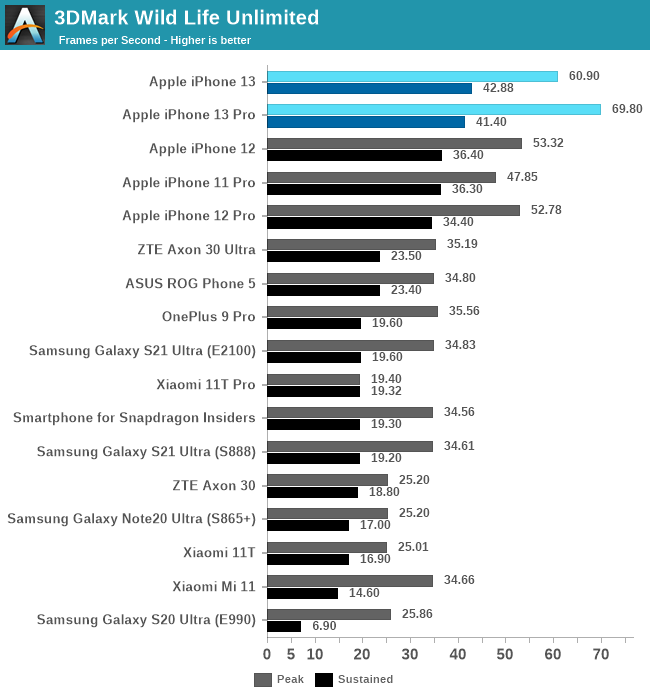
In the 3DMark Wild Life test, we see the 5-core A15 leap the A15 by +30%, while the 4-core showcases a +14% improvement, so quite close to what we predicted. The peak performance here is essentially double that of the nearest competitor, so Apple is likely low-balling things again.
In terms of sustained performance, the new chips continue to showcase a large difference in what they achieve with a cold phone versus a heated phone, interestingly, the 4-core iPhone 13 lands a bit ahead of the 13 Pro here, more on this later.

In Basemark GPU, the 13 Pro lands in at +28% over the 12 Pro, with the 4-core iPhone 13 only being slightly slower. Again, the phones throttle hard, however still manage to land with sustained performances well above the peak performances of the competition.

In GFXBench Aztec High, the 13 Pro lands in at a massive +46% performance advantage over the 12 Pro, while the 13 showcases a +19% boost. These are numbers that are above the expectations – in terms of microarchitectural changes the new A15 GPU appears to adopt the same double FP32 throughput as on the M1 GPU, seemingly adding extra units alongside the existing FP32/double-rate FP16 ALUs. The increased 32MB SLC will also likely help a lot with GPU bandwidth and hit-rates, so these two changes seem to be the most obvious explanations for the massive increases.
In terms of power and efficiency, I’m also migrating away from tables to bubble charts to better represent the spatial positioning of the various SoCs.
I’d also like to note here that I had went ahead and re-measured the A13 and A14 phones in their peak performance states, showcasing larger power figures than the ones we’ve published in the past. Reason for this is the methodology where we’re only able to measure via input power of the phone, as we cannot dismantle our samples and are lacking PMIC fuelgauge access otherwise. The iPhone 13 figures here are generally hopefully correct as I measured other scenarios up to 9W, however there is still a bit of doubt on whether the phone is drawing from battery or not. The sustained power figures have a higher reliability.
As noted, the A15’s peak performance is massively better, but also appearing that the phone is improving the power draw slightly compared to the A14, meaning we see large efficiency improvements.
Both the 13 and 13 Pro throttle quite quickly after a few minutes of load, but generally at different power points. The 13 Pro with its 5-core GPU throttles down to around 3W, while the 13 goes to around 3.6W.

In Aztec Normal, we’re seeing similar relative positioning both in performance and efficiency. The iPhones 13 and 13 Pro are quite closer in performance than expected, due to different throttling levels.

Finally, in Manhattan 3.1, the A15’s 5-core goes up +32%, while the 4-core goes up +18%. The sustained performance isn’t notably different between the two, and also represent smaller improvements over the iPhone 11 and 12 series.
Impressive GPU Performance, but quite limited thermals
Our results here showcase two sides of a coin: In terms of peak performance, the new A15 GPU is absolutely astonishing, and showcasing again improvements that are well above Apple’s marketing claims. The new GPU architecture, and possibly the new SLC allow for fantastic gains in performance, as well as efficiency.
What’s not so great, is the phone’s throttling. Particularly, we seem to be seeing quite reduced power levels on the iPhone 13 Pro, compared to the iPhone 13 as well as previous generation iPhones.
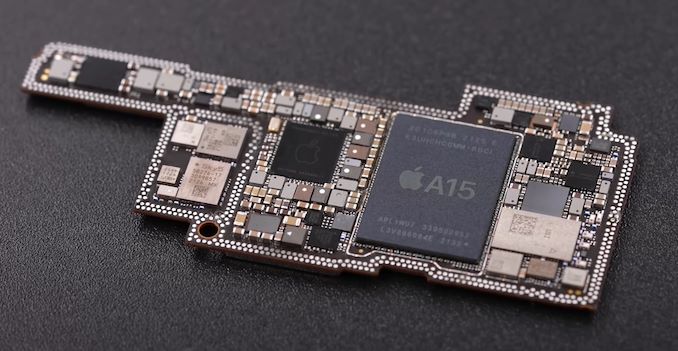
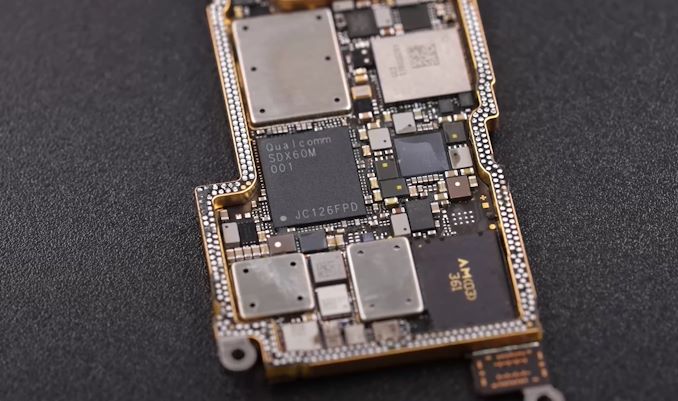
Source: 微机分WekiHome
The 13 Pro models this year come with a new PCB design, that’s even denser than what we’ve had on the previous generations, in order to facilitate the larger battery and new camera modules. What’s been extremely perplexing with Apple’s motherboard designs has been the fact that since they employed dual-layer “sandwich” PCBs, is that they’re packaging the SoC on the inside of the two soldered boards. This comes in contrast to other vendors such as Samsung, who also have adopted the “sandwich” PCB, but the SoC is located on the outer side of the assembly, making direct contact with the heat spreader and display mid-frame.
There are reports of the new iPhones throttling more under gaming and cellular connectivity – well, I’m sure that having the modem directly opposite the SoC inside the sandwich is a contributor to this situation. The iPhone 13 Pro showcasing lower sustained power levels may be tied to the new PCB design, and Apple’s overall iPhone thermal design is definitely amongst the worst out there, as it doesn’t do a good job of spreading the heat throughout the body of the phone, achieving a SoC thermal envelope that’s far smaller than the actual device thermal envelope.
No Apples to Apples in Gaming
In terms of general gaming performance, I’ll also want to make note of a few things – the new iPhones, even with their somewhat limited thermal capacity, are still vastly faster than give out a better gaming experience than competitive phones. Lately benchmarking actual games has been something that has risen in popularity, and generally, I’m all for that, however there are just some fundamental inconsistencies that make direct game comparisons not empirically viable to come to SoC conclusions.
Take Genshin Impact for example, unarguably the #1 AAA mobile game out there, and also one of the most performance demanding titles in the market right now, comparing the visual fidelity on a Galaxy S21 Ultra (Snapdragon 888), Mi 11 Ultra, and the iPhone 13 Pro Max:

Galaxy S21 Ultra - Snapdragon 888
Even though the S21 Ultra and the Mi 11 Ultra both feature the same SoC, they have very different characteristics in terms of thermals. The S21 Ultra generally sustains about 3.5W total device power under the same conditions, while the Mi 11 Ultra will hover between 5-6W, and a much hotter phone. The difference between the two not only exhibits itself in the performance of the game, but also in the visual fidelity, as the S21 Ultra is running much lower resolution due to the game having a dynamic resolution scaling (both phones had the exact same game settings).
The comparison between Android phones and iPhones gets even more complicated in that even with the same game setting, the iPhones still have slightly higher resolution, and visual effects that are just outright missing from the Android variant of the game. The visual fidelity of the game is just much higher on Apple’s devices due to the superior shading and features.
In general, this is one reason while I’m apprehensive of publishing real game benchmarks as it’s just a false comparison and can lead to misleading conclusions. We use specifically designed benchmarks to achieve a “ground truth” in terms of performance, especially in the context of SoCs, GPUs, and architectures.
The A15 continues to cement Apple’s dominance in mobile gaming. We’re looking forward to the next-gen competition, especially RDNA-powered Exynos phones next year, but so far it looks like Apple has an extremely comfortable lead to not have to worry much.



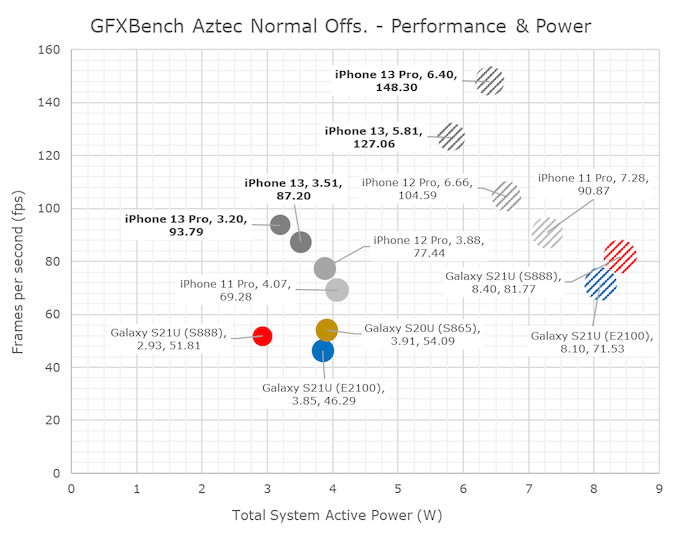
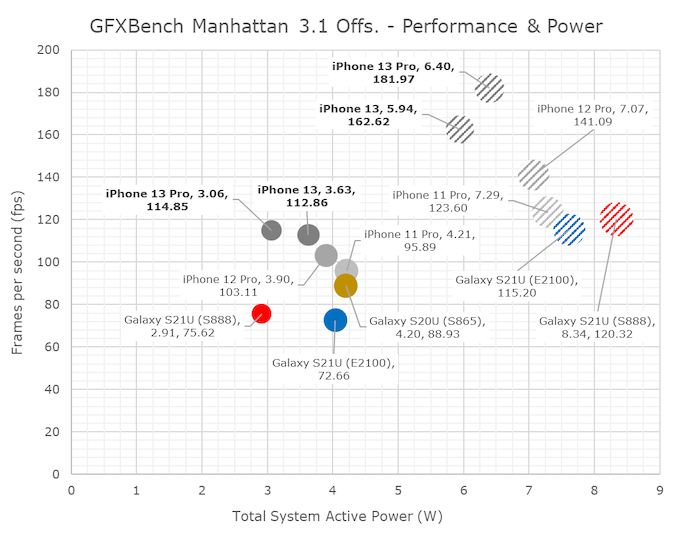










204 Comments
View All Comments
Calin - Tuesday, October 5, 2021 - link
There are plenty of Android phones with batteries around 5,000 mAh. However, I only remember one at 6,000 mAh and none higher than that.All in all, anything more than about 18-20 hours of actual battery life is excessive (considering the size and weight penalty versus actual time you could use it between recharges).
gund8912 - Monday, October 11, 2021 - link
I care about battery line not size of the battery.markiz - Monday, October 11, 2021 - link
They really don't. They have been at the bottom of any list for many years now, compared to other high end phones, and even more so compared to some cheaper phones.13 series does seem like a significant improvement though.
michael2k - Friday, October 15, 2021 - link
Very significant:https://www.anandtech.com/show/17004/apples-iphone...
akdj - Wednesday, February 16, 2022 - link
???I know I’m late to the party but whaaaa…?
As an owner of both, and since 2007 - it’s been a long time since I’ve seen/had/read about Android beating iPhone in any sort of battery or power longevity test… in real world usage.
And I believe there’s a limit to the size of battery allowed in a cell phone if you need or want to fly with it.
If I recall correctly it was, maybe still is 4,000mAh but I could be wrong
That said, the 11, 12, and now 13 Pro Max’s I’ve owned have eaten the S20, S21 Ultra and the Pix6 for lunch when it comes to measuring battery life.
I only mention these because I owned them simultaneously with each other and used them similarly so I speak from experience
That said, I don’t think it’s hard to believe a low powered cheap/burner Android phone has decent battery life. It probably forgoes a lot of radio power, cell bands and Wi-Fi options/radios. No NFC, LTE only with just local frequencies, maybe even 3g. A/B/G, maybe N Wi-Fi, small display and no always on. No storage for apps that eat your bandwidth and in turn your battery. Dim displays, tired SOCs, little RAM, little storage, and with the lack of power storage and memory comes the lack of desire to play games, buy decent apps, or even watch movies.
So sure, you might get a couple extra standby hours on a cheap Android but not a flagship option. I think my S21U had 12GB RAM! That’s insane and needs continued low voltage to maintain the info on your immediate random access memory!
The only options I’ve seen that truly do compete with the iPhone energy wise are either not available in America (only our problem), in some case Europe or are just not readily available in many western carriers.
And the flagships are usually neck and neck until the recent iPhone updates (since it seems the X/XS or 11 series) where they have just taken over with few exceptions that are hard if not impossible to find - even worse to get support.
Apple’s chip design is a massive achievement, and I believe one we’ve just begun to see the fruits of that labor. EG; M1/M1 Pr/M1 Max and soon to release M2’s architecture and the scaling used from the iPhone silicon to the Mac Pros.
Just the beginning… and if you want to game, all ya need now is an Xbox, leave the rest of the Wind-blows in the rear view (I’m playing Microsoft Flight Simulator 2021 on the series X and I have a desktop rig with a 3080. I notice almost no difference between them - Other than options for third party upgrades, liveries and high density airports - I believe will be here sooner than later on Xbox. As it, too, is running Windows at its core.
Why chase three and four thousand dollar gaming rigs when they offer a $500 box that every Tom Dick and Henry the developers will be targeting the next several years?
Makes little to no sense. Not even in productivity or code compilation.
Sure, Alder Lake unlocked and a 3090 ($2500-$3000 if you can find one, GPU only) can best the MacBook Pro M1 Max, but not by much (games aside, remember the Xbox) in the benchmarks or actual software that was tested for making and printing money - ala Photoshop, Premier and After Effects, Audition and FCP/Logic - massive spreadsheets or huge RAW file batch processing in Lightroom, not only does the M1 crush in the laptop realm but it’s a monster on the iPhone 12/13 and the 2021 iPad with M1! And you don’t need to worry, your battery will last all day
Ppietra - Monday, October 4, 2021 - link
You can see that S21U at 8.3W only achieves 120 fps, almost the same as the A15 at 3W.melgross - Monday, October 4, 2021 - link
You seem to be just making things up. Apple’s new phones are getting excellent battery life according to every review, with the 13 Pro Max being given the top rating for battery life.18,000mAh battery? What phone has that?
emn13 - Monday, October 4, 2021 - link
The largest battery I can find is the one: "doogee s88 pro" which is "just" 10000mAh.However, even if deil is exaggerating, there is a kernel of truth to the battery life complaints, and that's due to idle power draw, which apparently is not as great.
gsmarena (link unfortunately removed to satisfy the absurd anandtech spam detector) has a battery life estimator, based on a sliding scales of how much legacy calling/web browsing/video watching you do, but critically it includes the standby power draw, and apple devices are nowhere near the top. The best rated is still the 11 Pro Max, which beats the 13 and 13 pro by a considerable margin.
But even vs. more normally battery-endowed androids (which often still tend to have 4000mAh+ batteries) although the iphone fare OK, they're nothing special. The
Sony Xperia 10 III scores particularly well (probably because it's much slower), at 137h vs. the iphone 13's 89h.
But you can fiddle the sliders to your hearts content. The higher your active usage, the better apple does, but even the most extreme users will likely see longer battery life on the more efficiently tuned androids.
Course, there are also androids that do a lot worse, mind you; it's just that apples phenomenal efficiency under load doesn't translate trivially to battery life because the batteries are still quite small, and perhaps because standby draw isn't anything particularly great.
The Garden Variety - Monday, October 4, 2021 - link
There actually was an 18,000mAh phone. It was made by Energizer (yeah, that one) and called the Power Max P18K Pop. Announced in 2019, offered for sale only in Europe, dunno if it's still available. Some quick Googling would say no. Oh, and it was the size of a particularly beefy paperback book.FunBunny2 - Monday, October 4, 2021 - link
Oh, and it was the size of a particularly beefy paperback book.dredge up a lower brain stem memory, OK! there was a flashback scene in a late "X Files" where Mulder pulls one of the vewy, vewy early mobiiiile phones from his trench coat. you remember, the ones the size of a baseball bat?